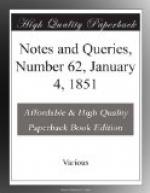GOMER.
[Moxon, in his Mechanick Exercises, vol. ii. p. 356. 4to. 1683, says: “Every printing-house is by the custom of time out of mind called a chappel; and all the workmen that belong to it are members of the chappel: and the oldest freeman is father of the chappel. I suppose the style was originally conferred upon it by the courtesie of some great Churchman, or men, (doubtless, when chappels were in more veneration than of late years they have been here in England), who, for the books of divinity that proceeded from a printing-house, gave it the reverend title of chappel.”]
Cockade is a ribband worn in the hat, as defined by Dr. Johnson. Query, What is the origin of its use by officers of the army and navy; who are privileged to wear it; when was it first introduced; and by what authority, if any, is it sanctioned or confined to the army and navy?
A.E.
Suem, Ferling, Grasson—In a copy of Court Roll, dated the 40th year of Elizabeth, and relating {8} to the manor of Rotherfield, co. Sussex, these words occur:—
“R. K. cepit extra manus domini unam suem tr[e] nat’ de ferling,” &c.
I shall be obliged to any of your correspondents who will explain the words suem and ferling.
What is the etymology of grasson, a word used in some north-country manors for a fine paid on alienation of copyhold lands?
C.W.G.
Cranmer’s Descendants.—Being much interested in everything that concerns the martyrs of the Reformation, and not the less so from being descended (in the female line) from the father of Archbishop Cranmer, I should be very glad if any of your correspondents could inform me whether there are any of his male descendants still in existence. Gilpin, in his Lives of the Reformers, says that the Archbishop’s wife and children lived in great obscurity. This was probably on account of the prejudice, which had hardly passed away, against the marriage of the clergy; but surely the descendants of so great a man, if there be such, have not lost the records or pedigree by which their descent can be verified.
C.D.F.
Collections of Pasquinades.—Can any of your correspondents inform me whether a collection has ever been published of the satirical verses affixed to the torso of Menelaus, at the corner of the Palazzo Braschi at Rome, and commonly known as Pasquinades, from the name of a tailor whose shop stood near the place of its discovery? (See Nibby Itinerario di Roma, ii. 409.) I send you a specimen which I do not remember to have seen in print. It was occasioned by the Pope Pius VI. (Braschi) having placed his own coat of arms in various parts of St. Peter’s. They consisted of the double-headed eagle, two stars, a lily, and the head of a boy, puffing at it.
“Redde aquilam imperio; Gallorum
lilia regi;
Sidera redde polo; caetera
Brasche tibi.”




